
Below we provide a list of the space missions that are most relevant to the WHPI initiative. More information on these missions can be found on the NASA Science Missions website. We acknowledge that there are a lot of other observations from ground-based observatories and space missions from other space agencies that are critically important for WHPI and the WHPI observing campaigns and will be used in the WHPI science projects.
From NASA's Eyes On the Solar System
Click a category to skip to missions within it (<esc> or back to return to top):
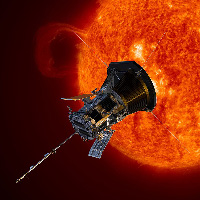
(Also in Heliosphere category) (From NASA) NASA's historic Parker Solar Probe (PSP) mission will revolutionize our understanding of the Sun, where changing conditions can propagate out into the solar system, affecting Earth and other worlds. Parker Solar Probe will travel through the Sun’s atmosphere, closer to the surface than any spacecraft before it, facing brutal heat and radiation conditions — and ultimately providing humanity with the closest-ever observations of a star.
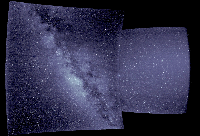
In order to unlock the mysteries of the Sun's atmosphere, Parker Solar Probe will use Venus’ gravity during seven flybys over nearly seven years to gradually bring its orbit closer to the Sun. The spacecraft will fly through the Sun’s atmosphere as close as 3.8 million miles to our star’s surface, well within the orbit of Mercury and more than seven times closer than any spacecraft has come before. (Earth’s average distance to the Sun is 93 million miles.)
Flying into the outermost part of the Sun's atmosphere, known as the corona, for the first time, Parker Solar Probe will employ a combination of in situ measurements and imaging to revolutionize our understanding of the corona and expand our knowledge of the origin and evolution of the solar wind. It will also make critical contributions to our ability to forecast changes in Earth's space environment that affect life and technology on Earth.
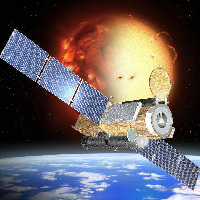
(From NASA) Hinode is an international mission to study our nearest star, the sun. To accomplish this, the Hinode mission includes a suite of three science instruments -- the Solar Optical Telescope, X-ray Telescope and Extreme Ultraviolet Imaging Spectrometer. Together, these instruments will study the generation, transport, and dissipation of magnetic energy from the photosphere to the corona and will record how energy stored in the sun's magnetic field is released, either gradually or violently, as the field rises into the sun’s outer atmosphere.
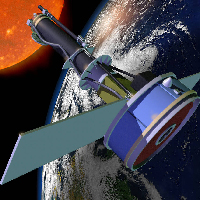
(From NASA) The Interface Region Imaging Spectrograph (IRIS) is a NASA Small Explorer Mission to observe how solar material moves, gathers energy, and heats up as it travels through a little-understood region in the sun's lower atmosphere. Tracking how material and energy move through this region is a crucial part of understanding the dynamics of the sun. Such information can help explain what causes the ejection of solar material -- from the steady stream of the solar wind to larger, explosive eruptions such as coronal mass ejections (CMEs) -- that travels toward Earth and causes space weather that can disrupt human technology.
Visible in ultraviolet light, the two regions closest to the sun are called the chromosphere and the transition region. They form a violently dynamic interface region in which hot and cold plasma are mixed over a range of heights, stretching from the sun's surface to several thousand miles up. This location is where one of the most mysterious occurrences on the sun takes place. Usually the closer you get to a heat source, such as a fire, the hotter it gets -- but the solar atmosphere doesn't do that. The solar atmosphere gets hotter as it gets further away from the sun, and scientists don't yet have enough information to distinguish between various theories on why this happens. The atmosphere changes from 6,000 K at the surface to about a million K at the top of the transition region. The temperatures continue to increase up to millions of degrees in the sun's upper atmosphere, the corona, but since the lowermost layers contain more material, the strongest heating is believed to occur there.
Tracking the complex processes within these layers of the solar atmosphere requires instrument and modeling capabilities that are within technological reach for the first time. IRIS is the first mission designed to simultaneously observe the range of temperatures specific to the chromosphere and transition region at very high spatial and temporal resolution -- going beyond earlier missions that were lower resolution or did not cover a wide range of temperatures.
IRIS also draws on state of the art computer modeling sophisticated enough to deal with the complexity of this area. In combination, IRIS's resolution, wide temperature coverage and computer modeling will enable scientists to map plumes of solar material as they move throughout the region and to pinpoint where in their travels they gain energy and heat.
The mission's general science objectives are to answer the following questions:
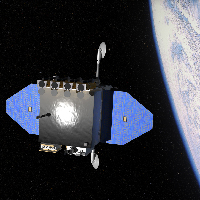
(From NASA) The Solar Dynamics Observatory (SDO) is the first mission to be launched for NASA's Living With a Star (LWS) Program, a program designed to understand the causes of solar variability and its impacts on Earth. SDO is designed to help us understand the Sun's influence on Earth and Near-Earth space by studying the solar atmosphere on small scales of space and time and in many wavelengths simultaneously.
SDO's goal is to understand, driving towards a predictive capability, the solar variations that influence life
on Earth and humanity's technological systems by determining:
How the Sun's magnetic field is generated and structured
How this stored magnetic energy is converted and released into the heliosphere and geospace in the form of solar wind,
energetic particles, and variations in the solar irradiance.
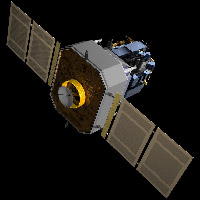
(See NASA) SOHO, the Solar & Heliospheric Observatory, is a project of international collaboration between ESA and NASA to study the Sun from its deep core to the outer corona and the solar wind. SOHO was launched on December 2, 1995 and carried twelve instruments on board. SOHO orbits around the First Lagrangian Point (L1) at approximately 1.5 million kilometres away from Earth (about four times the distance of the Moon). SOHO has provided an unprecedented breadth and depth of information about the Sun, from its interior, through the hot and dynamic atmosphere, to the solar wind and its interaction with the interstellar medium. SOHO made many important discoveries, such as detecting waves travelling through the corona and identifying the source of the fast solar wind. Because of its spectacular successes, the mission was extended five times. As of today, the LASCO Coronagraphs on SOHO are still taking science data that are critical for space weather operations.
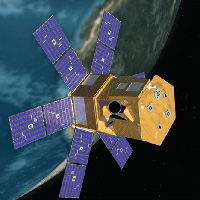
(From NASA/LASP) The Solar Radiation and Climate Experiment (SORCE) is a NASA-sponsored satellite mission that is providing state-of-the-art measurements of incoming x-ray, ultraviolet, visible, near-infrared, and total solar radiation. The measurements provided by SORCE specifically address long-term climate change, natural variability and enhanced climate prediction, and atmospheric ozone and UV-B radiation. These measurements are critical to studies of the Sun; its effect on our Earth system; and its influence on humankind.
The SORCE spacecraft was launched on January 25, 2003 on a Pegasus XL launch vehicle to provide NASA’s Earth Science Enterprise (ESE) with precise measurements of solar radiation. It launched into a 645 km, 40 degree orbit and is operated by the Laboratory for Atmospheric and Space Physics (LASP) at the University of Colorado (CU) in Boulder, Colorado, USA. It will continue the precise measurements of total solar irradiance (TSI) that began with the ERB instrument in 1979 and has continued to the present with the ACRIM series of measurements. SORCE will also provide the measurements of the solar spectral irradiance from 1nm to 2000nm, accounting for 95% of the spectral contribution to TSI. SORCE carries four instruments including the Spectral Irradiance Monitor (SIM), Solar Stellar Irradiance Comparison Experiment (SOLSTICE), Total Irradiance Monitor (TIM), and the XUV Photometer System (XPS).
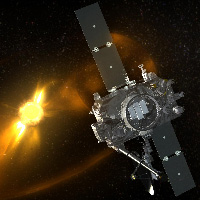
(Also in Heliosphere category) (From NASA) Solar TErrestrial RElations Observatory (STEREO) is the third mission in NASA's Solar Terrestrial Probes program (STP). The mission, launched in October 2006, has provided a unique and revolutionary view of the Sun-Earth System. The two nearly identical observatories - one ahead of Earth in its orbit, the other trailing behind - have traced the flow of energy and matter from the Sun to Earth. STEREO has revealed the 3D structure of coronal mass ejections; violent eruptions of matter from the sun that can disrupt satellites and power grids, and help us understand why they happen. STEREO is a key addition to the fleet of space weather detection satellites by providing more accurate alerts for the arrival time of Earth-directed solar ejections with its unique side-viewing perspective.
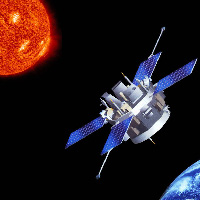
(From NASA) The Advanced Composition Explorer (ACE) spacecraft collects and analyzes particles of solar, interplanetary, interstellar and galactic origins, spanning the energy range from solar-wind ions to galactic cosmic rays traveling at nearly the speed of light.Studying these particles contributes to our understanding of the Sun and its interaction with Earth, and of the formation and evolution of the solar system. ACE also provides near-real-time solar wind information for space weather forecasting. ACE was launched in 1997 and has operated far beyond its expected lifetime. It operates in an orbit around the L1 point which is a point of Earth-Sun gravitational equilibrium at about 1.5 million km from the Earth.
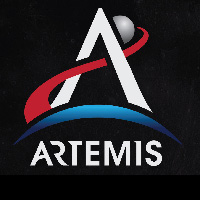
(From NASA) An extension to the THEMIS mission is to send two of the THEMIS satellites into lunar orbit to study the magnetospheric environment near the Moon. The new mission is named ARTEMIS (Acceleration, Reconnection Turbulence, and Electrodynamics of Moon's Interaction with the Sun). The outermost two THEMIS spacecraft (Probes B and C) are on route to the Moon, where they will become the ARTEMIS mission's Probes 1 and 2, tasked with studying not only the tenuous cavity carved out by the Moon in the supersonic solar wind, but also reconnection, particle energization and turbulence in both the solar wind and the Earth's distant magnetotail at lunar distance.
In support of the PSP 4th Perihelion pass, ARTEMIS is planning continuous Fast Survey observations for the period January 28 – February 3 on ARTEMIS; the 2 spacecraft (along with the moon) will be in the solar wind at the time and will provide really good information of the structures coming by. So we hope to examine the evolution of the solar wind structures seen by PSP as they arrive to Earth. (MMS at the dayside too, will provide a 3rd point). THEMIS and Arase on the dawn and dusk of the magnetosphere. An interesting constellation to see the effects of the solar wind phenomena at Earth. The THEMIS Ground Based Observatories will also be collecting good data in this period, on the nightside.
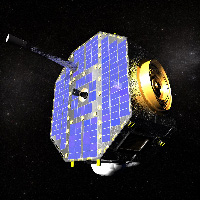
(From NASA) The Interstellar Boundary Explorer (IBEX) mission science objective is to discover the nature of the interactions between the solar wind and the interstellar medium at the edge of our solar system. Roughly the size of a card table, the Interstellar Boundary Explorer is the latest in NASA’s series of low-cost, rapidly developed Small Explorers spacecraft. IBEX will go a step further than Voyager and it will provide measurements helping to understand the interaction between the solar wind and the interstellar medium.

(Also in Solar category) (From NASA) NASA's historic Parker Solar Probe (PSP) mission will revolutionize our understanding of the Sun, where changing conditions can propagate out into the solar system, affecting Earth and other worlds. Parker Solar Probe will travel through the Sun’s atmosphere, closer to the surface than any spacecraft before it, facing brutal heat and radiation conditions — and ultimately providing humanity with the closest-ever observations of a star.

In order to unlock the mysteries of the Sun's atmosphere, Parker Solar Probe will use Venus’ gravity during seven flybys over nearly seven years to gradually bring its orbit closer to the Sun. The spacecraft will fly through the Sun’s atmosphere as close as 3.8 million miles to our star’s surface, well within the orbit of Mercury and more than seven times closer than any spacecraft has come before. (Earth’s average distance to the Sun is 93 million miles.)
Flying into the outermost part of the Sun's atmosphere, known as the corona, for the first time, Parker Solar Probe will employ a combination of in situ measurements and imaging to revolutionize our understanding of the corona and expand our knowledge of the origin and evolution of the solar wind. It will also make critical contributions to our ability to forecast changes in Earth's space environment that affect life and technology on Earth.

(From the PUNCH website) PUNCH is a NASA Small Explorer (SMEX) mission to better understand how the mass and energy of the Sun’s corona become the solar wind that fills the solar system. Four suitcase-sized satellites will work together to produce images of the entire inner solar system around the clock.
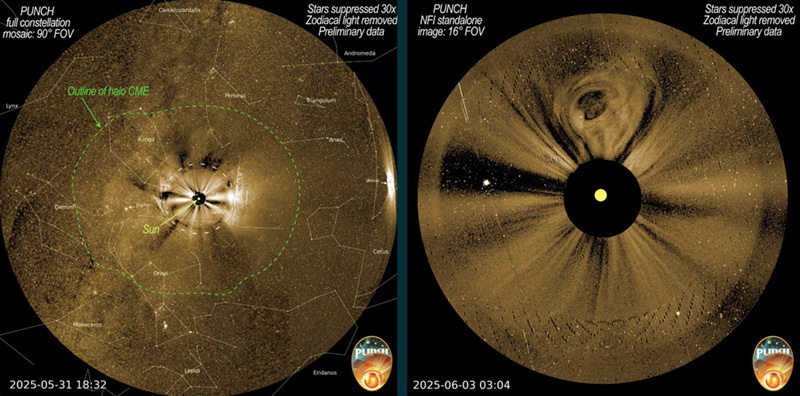
PUNCH will make global, 3D observations of the young solar wind, from the outermost solar atmosphere to the inner heliosphere. Images of unprecedented quality will help to close a 60-year gap in measurement and understanding of what occurs in this region of space. PUNCH launched on March 11, 2025.
The PUNCH mission consists of a constellation of four small satellites in Sun-synchronous, low Earth orbit that together will produce deep-field, continuous, 3D images of the solar corona as it makes a transition to the young solar wind: from 1.5° (6 R☉) to 45° (180 R☉) from the Sun. The PUNCH cameras sense normal visible light and its linear polarization which allows the 3D location of solar wind features to be measured.

(Also in Solar category) (From NASA) Solar TErrestrial RElations Observatory (STEREO) is the third mission in NASA's Solar Terrestrial Probes program (STP). The mission, launched in October 2006, has provided a unique and revolutionary view of the Sun-Earth System. The two nearly identical observatories - one ahead of Earth in its orbit, the other trailing behind - have traced the flow of energy and matter from the Sun to Earth. STEREO has revealed the 3D structure of coronal mass ejections; violent eruptions of matter from the sun that can disrupt satellites and power grids, and help us understand why they happen. STEREO is a key addition to the fleet of space weather detection satellites by providing more accurate alerts for the arrival time of Earth-directed solar ejections with its unique side-viewing perspective.
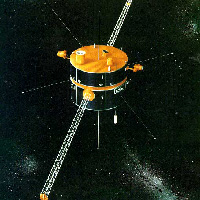
(From NASA) Wind is a spin stabilized spacecraft launched with a Delta II rock on November 1, 1994. After several orbits through the magnetosphere, Wind was placed in a halo orbit around the L1 Lagrange point -- more than 200 Re upstream of Earth -- in early 2004 to observe the unperturbed solar wind that is about to impact the magnetosphere of Earth. Wind, together with Geotail, Polar, SoHO and Cluster, constitute a cooperative scientific satellite project designated the International Solar Terrestrial Physics (ISTP) program that aims at gaining improved understanding of the physics of solar terrestrial relations.
The primary science objectives of the Wind mission are:
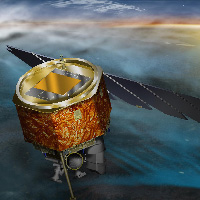
(From NASA) The Aeronomy of Ice in the Mesosphere (AIM) mission is the first detailed exploration of Earth's unique and elusive clouds that are literally on the "edge of space." Other space-based and ground-based measurements have probed some aspects of this unusual phenomenon in Earth's mesosphere, but very little is known about how these clouds form over the poles, why they are being seen at lower latitudes than ever before, or why they have been growing brighter and more frequent. Over the course of its two-year mission, AIM will help answer these questions by documenting for the first time the entire complex life cycle of these clouds.
Quick Facts
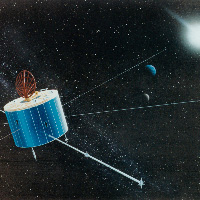
(From NASA) Geotail is a joint mission of NASA and the Japanese Aerospace Exploration Agency (JAXA). Following the completion of its primary mission, studying the dynamics of Earth’s magnetotail, Geotail’s orbit was modified to allow its study of solar wind’s interaction with the magnetosphere.
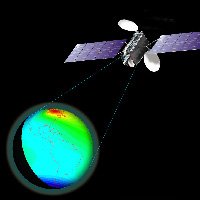
(From NASA) The Global-scale Observations of the Limb and Disk, or GOLD, mission is designed to explore the nearest reaches of space. Capturing never-before-seen images of Earth’s upper atmosphere, GOLD explores in unprecedented detail our space environment — which is home to astronauts, radio signals used to guide airplanes and ships, as well as satellites that provide communications and GPS systems. The more we know about the fundamental physics of this region of space, the more we can protect our assets there.
Gathering observations from geostationary orbit above the Western Hemisphere, GOLD measures the temperature and composition of neutral gases in Earth’s thermosphere. This part of the atmosphere co-mingles with the ionosphere, which is made up of charged particles. Both the Sun from above and terrestrial weather from below can change the types, numbers, and characteristics of the particles found here — and GOLD helps track those changes.
Activity in this region is responsible for a variety of key space weather events. GOLD scientists are particularly interested in the cause of dense, unpredictable bubbles of charged gas that appear over the equator and tropics, sometimes causing communication problems. As we discover the very nature of the Sun-Earth interaction in this region, the mission could ultimately lead to ways to improve forecasts of such space weather and mitigate its effects.
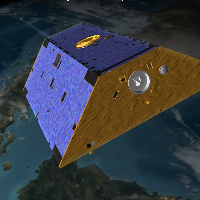
(From NASA) The Gravity Recovery and Climate Experiment (GRACE) mission was selected as the second mission under the NASA Earth System Science Pathfinder (ESSP) Program. Designed for a nominal mission lifetime of five years, GRACE is currently operating in an extended mission phase. GRACE consists of two identical spacecraft that fly about 220 kilometers (137 miles) apart in a polar orbit 500 kilometers (310 miles) above Earth. GRACE maps Earth's gravity field by making accurate measurements of the distance between the two satellites, using GPS and a microwave ranging system. Another goal of the mission is to create a better profile of Earth's atmosphere. GRACE results are making a huge contribution to the goals of NASA's Science Mission Directorate, Earth Observation System (EOS) and global climate change studies.
(From NASA) The Ionospheric Connection Explorer (ICON) will study the frontier of space: the dynamic zone high in our atmosphere where terrestrial weather from below meets space weather above. In this region, the tenuous gases are anything but quiet, as a mix of neutral and charged particles travel through in giant winds. These winds can change on a wide variety of time scales -- due to Earth's seasons, the day's heating and cooling, and incoming bursts of radiation from the sun.
This region of space and its changes have practical repercussions, given our ever-increasing reliance on technology -- this is the area through which radio communications and GPS signals travel. Variations there can result in distortions or even complete disruption of signals. In order to understand this complicated region of near-Earth space, called the ionosphere, NASA has developed the ICON mission. To understand what drives variability in the ionosphere requires a careful look at a complicated system that is driven by both terrestrial and space weather.
ICON will help determine the physics of our space environment and pave the way for mitigating its effects on our technology, communications systems and society.
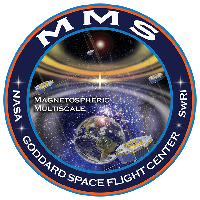
(From NASA) Magnetospheric Multiscale (MMS) investigates how the Sun’s and Earth’s magnetic fields connect and disconnect, explosively transferring energy from one to the other in a process that is important at the Sun, other planets, and everywhere in the universe, known as magnetic reconnection. Reconnection limits the performance of fusion reactors and is the final governor of geospace weather that affects modern technological systems such as telecommunications networks, GPS navigation, and electrical power grids. Four identically instrumented spacecraft measure plasmas, fields, and particles in a near-equatorial orbit that will frequently encounter reconnection in action.
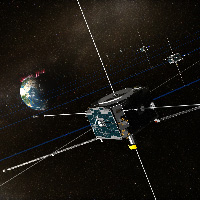
(From NASA) NASA's Time History of Events and Macroscale Interactions during Substorms (THEMIS) aims to resolve one of the oldest mysteries in space physics, namely to determine what physical process in near-Earth space initiates the violent eruptions of the aurora that occur during substorms in the Earth's magnetosphere. THEMIS is a 2-year mission consisting of 5 identical probes that will study the violent colorful eruptions of Auroras.
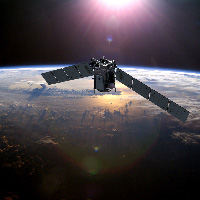
(From NASA) The primary science objective of the Thermosphere Ionosphere Mesosphere Energetics and Dynamics (TIMED) mission is to understand the energy transfer into and out of the Mesosphere and Lower Thermosphere/Ionosphere (MLTI) region of the Earth's atmosphere (energetics), as well as the basic structure (i.e., pressure, temperature, and winds) that results from the energy transfer into the region (dynamics). Located between approximately 40-110 miles (60-180 kilometers) above the Earth's surface, the MLTI region is sensitive to external influences from the sun above and atmospheric layers below it. Its chemical and thermal balance can change rapidly due to naturally-occurring and/or human-induced changes to the energy contained within this region.
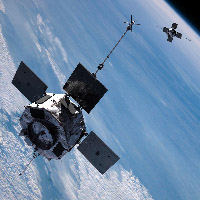
(From NASA) Space weather is the source of aurora that shimmer in the night sky, but it also can disrupt satellites, cause power grid failures and disrupt GPS communications. The Van Allen Probes will help scientists to understand this region and to better design spacecraft that can survive the rigors of space. As the second mission in NASA's Living With a Star program, the Van Allen Probes will take its place as part of a fleet of spacecraft that may someday help predict space weather before it even impacts Earth's environs.
While earlier missions have sent back some information about the radiation belts, the Van Allen Probes are the first to use two spacecraft in tandem. As they speed through the belts at some 2000 mph, the spacecraft will naturally pass through changing conditions. But a single moving spacecraft cannot discern whether any changes it observes are due to traveling disturbances, or if the spacecraft simply flew through two static, but differing, regions. Two spacecraft with identical instruments, however, can distinguish between these possibilities.
Launched on August 30, 2012, the two Van Allen Probes spacecraft operate in the harsh conditions they are studying. While other satellites have the luxury of turning off or protecting themselves in the middle of intense space weather, the Van Allen Probes must continue to collect data, and therefore, been built to withstand the constant bombardment of particles and radiation they will experience in this intense area of space.
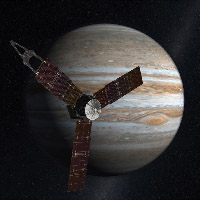
(From NASA) Juno's principal goal is to understand the origin and evolution of Jupiter. Underneath its dense cloud cover, Jupiter safeguards secrets to the fundamental processes and conditions that governed our solar system during its formation. As our primary example of a giant planet, Jupiter can also provide critical knowledge for understanding the planetary systems being discovered around other stars. With its suite of science instruments, Juno will investigate the existence of a solid planetary core, map Jupiter's intense magnetic field, measure the amount of water and ammonia in the deep atmosphere, and observe the planet's auroras.
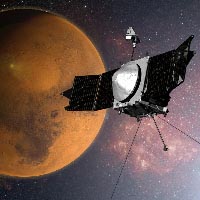
(From NASA) The Mars Atmosphere and Volatile EvolutioN (MAVEN) mission is part of NASA's Mars Scout program, funded by NASA Headquarters. Launched in Nov. 2013, the mission will explore the Red Planet’s upper atmosphere, ionosphere and interactions with the sun and solar wind. Scientists will use MAVEN data to determine the role that loss of volatiles from the Mars atmosphere to space has played through time, giving insight into the history of Mars' atmosphere and climate, liquid water, and planetary habitability.
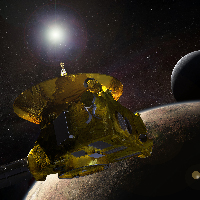
(From NASA) The New Horizons mission is helping us understand worlds at the edge of our solar system by making the first reconnaissance of the dwarf planet Pluto and by venturing deeper into the distant, mysterious Kuiper Belt – a relic of solar system formation. New Horizons launched in January 2006; it swung past Jupiter for a gravity boost and scientific studies in February 2007, and conducted a six-month-long reconnaissance flyby study of Pluto and its moons in summer 2015, culminating with Pluto closest approach on July 14, 2015.
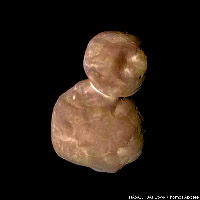
The New Horizon team used the Hubble Space Telescope to search for its post-Pluto Kuiper Belt flyby target. New Horizons spacecraft flew past Ultima Thule (now officially named 486958 Arrokoth) in the early hours of Jan 1 2019. This was the first-ever close-up exploration of a small Kuiper Belt object and the farthest exploration of any planetary body in history.